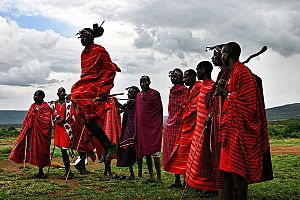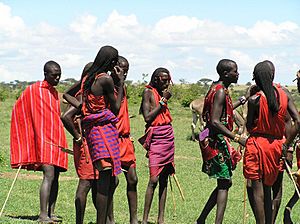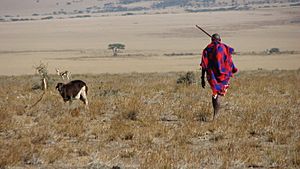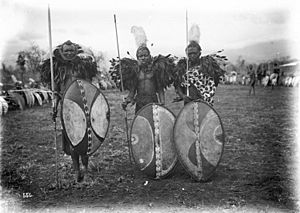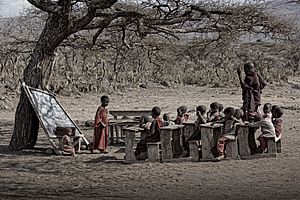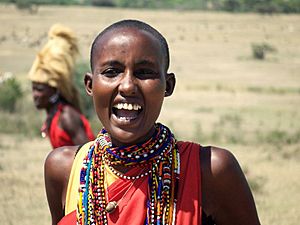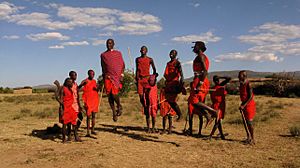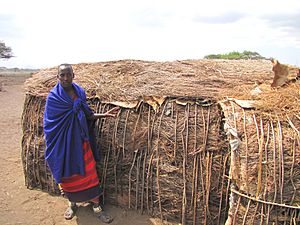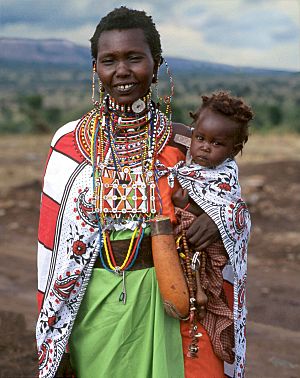Maasai facts for kids
The Maasai are an ethnic group of people that live in Kenya and in the north of Tanzania. They are well known for the way that they dress and because they live near some national parks in Africa that a lot of tourists go to. They speak a language called Maa.
The Maasai are an old nomad African tribe in the group of Nilotes who have always lived in Africa principally in the north of Tanzania and southern Kenya. They were discovered by settlers around the 19th century.
They live near the african savannah in animal reserves, for example the Masaai Mara reserve and the Serengeti.
The women build houses called Manyatta; the men build a fence around the village to protect them from lions.
The Masaai people live with animals because they are pastrolists. The more cattle a Maasai man has, the richer he is. They can’t live without animals because their wealth comes from them . The Masaai drink cow’s blood because they believe they will be stronger.
The Maasai speak Maa,very similar in pronuncuation to their Nilotic counterparts, the Luo and Kalenjin.
They are Christians, animists (their own religion) and some Maasai are muslim.
Physically, they are very tall and slim. Everybody wears bandannas and beaded jewellry, apply dye from dried up cow blood.
They shave their women during marriages and their men pay a lot of dowry,in form of cattle to the bride's family.
During initiation, the boys in their teen ages, jump over fire and kill a lion in order to be called men. There on, they can get married.
History
The Maasai inhabit the African Great Lakes region and arrived via South Sudan. Most Nilotic speakers in the area, including the Maasai, the Turkana and the Kalenjin, are pastoralists and are famous for their fearsome reputations as warriors and cattle rustlers.
Many ethnic groups that had already formed settlements in the region were forcibly displaced by the incoming Maasai.
The Maasai territory reached its largest size in the mid-19th century and covered almost all of the Great Rift Valley and adjacent lands from Mount Marsabit in the north to Dodoma in the south.
The Maasai in Tanganyika (now mainland Tanzania) were displaced from the fertile lands between Mount Meru and Mount Kilimanjaro, and most of the fertile highlands near Ngorongoro in the 1940s. More land was taken to create wildlife reserves and national parks: Amboseli National Park, Nairobi National Park, Maasai Mara, Samburu National Reserve, Lake Nakuru National Park and Tsavo in Kenya; and Lake Manyara, Ngorongoro Conservation Area, Tarangire and Serengeti National Park in what is now Tanzania.
Culture
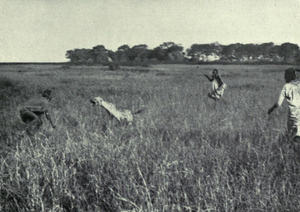
The Maasai worship a single deity called Enkai, Nkai, or Engai. Engai has a dual nature, represented by two colours: Engai Narok (Black God) is benevolent, and Engai Na-nyokie (Red God) is vengeful.
The Maasai also have a totemic animal, which is the lion; however, the animal can be killed.
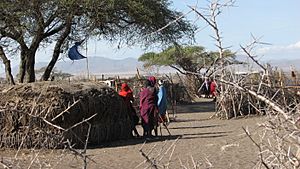
Traditional Maasai lifestyle centres around their cattle, which constitute their primary source of food. A man's wealth is measured in cattle and children (note that the wives or women are also counted as part of the children). A herd of 50 cattle is respectable, and the more children the better. A man who has plenty of one but not the other is considered to be poor.
All of the Maasai's needs for food are met by their cattle. They eat their meat, drink their milk daily, and drink their blood on occasion. Bulls, goats, and lambs are slaughtered for meat on special occasions and ceremonies. Though the Maasai's entire way of life has historically depended on their cattle, more recently with their cattle dwindling, the Maasai have grown dependent on food such as sorghum, rice, potatoes and cabbage (known to the Maasai as goat leaves).
One common misconception about the Maasai is that each young man is supposed to kill a lion before he can enter adulthood. Lion hunting was an activity of the past, but it has been banned in East Africa – yet lions are still hunted when they maul Maasai livestock.
Hair
Upon reaching the age of 3 "moons", the child is named and the head is shaved clean apart from a tuft of hair, which resembles a cockade, from the nape of the neck to the forehead. Warriors are the only members of the Maasai community to wear long hair, which they weave in thinly braided strands. Graduation from warrior to junior elder takes place at a large gathering known as Eunoto. The long hair of the former warriors is shaved off; elders must wear their hair short.
Music and dance
Maasai music traditionally consists of rhythms provided by a chorus of vocalists singing harmonies while a song leader, or olaranyani, sings the melody. Unlike most other African tribes, Maasai widely use drone polyphony.
Women chant lullabies, humming songs, and songs praising their sons. When many Maasai women gather together, they sing and dance among themselves.
Eunoto, the coming-of-age ceremony of the warrior, can involve ten or more days of singing, dancing and ritual.
Diet
Traditionally, the Maasai diet consisted of raw meat, raw milk, honey and raw blood from cattle.
Most of the milk is consumed as fermented milk or buttermilk (a by-product of butter making). Milk consumption figures are very high by any standards.
The Maasai herd goats and sheep, including the Red Maasai sheep, as well as the more prized cattle.
Although consumed as snacks, fruits constitute a major part of the food ingested by children and women looking after cattle as well as morans in the wilderness.
Medicine
The Maasai people tend to use the environment when making their medicines due to the high cost of Western treatments. These medicines are derived from trees, shrubs, stems, roots, etc. These can then be used in a multitude of ways including being boiled in soups and ingested to improve digestion and cleanse the blood. Some of these remedies can also be used in the treatment or prevention of diseases. The Maasai people also add herbs to different foods to avoid stomach upsets and give digestive aid. The use of plant-based medicine is a crucial part of Maasai life.
Shelter
Clothing
Maasai clothing symbolises ethnic group membership, a pastoralist lifestyle, as well as an individual's social position. From this they can decide the roles they undertake for the tribe. Jewellery also can show an individual's gender, relationship status, and age. Maasai traditional clothing is a means of tribal identification.
The Maasai began to replace animal skin, calf hides and sheep skin with commercial cotton cloth in the 1960s.
Shúkà is the Maa word for sheets traditionally worn and wrapped around the body. These are typically red, sometimes integrated with other colours and patterns. One-piece garments known as kanga, a Swahili term, are common. Maasai near the coast may wear kikoi, a sarong-like garment that comes in many different colours and textiles.
Notable Maasai
- Joseph Ole Lenku – Cabinet Secretary of Kenya for Interior and Coordination of National Government from 2012 to 2014
- Jackson Ole Sapit - Sixth Archbishop and Primate of the Anglican Church of Kenya
- David Rudisha – Middle-distance runner and 800-meter world record holder
- Edward Sokoine – Prime Minister of Tanzania from 1977 to 1980 and again from 1983 to 1984
- Edward Lowassa – Prime Minister of Tanzania from 2005 to 2008. 2nd runner up to president John Pombe Magufuli in the 2015 Tanzania General Elections.
- Olekina Ledama – Founder, Maasai Education Discovery
- James Ole Kiyiapi – associate professor at Moi University and permanent secretary in the Ministries of Education and Local Government
- Linus Kaikai - Kenyan journalist and Chair of the Kenya Editors Guild
- William Ole Ntimama – Former Kenyan politician and leader of the Maa community
- Francis Ole Kaparo – Former Speaker of the National Assembly of Kenya
- Joseph Nkaissery – Former Cabinet Secretary of Kenya for Interior and Coordination of National Government from 2014 to his death in 2017
- Nice Nailantei Lengete – First woman to address the Maasai elders council at Mount Kilimanjaro
- Katoo Ole Metito – Member of Parliament for Kajiado South sub county
- Mbatian - Prophet after whom Batian Peak, the highest peak of Mount Kenya, is named


